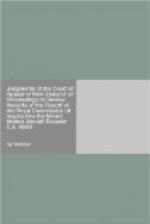In his judgment in the Court in Re the Royal Commission on the State Services (1962) N.Z.L.R. 96, 117, Cleary J. while stressing the wide discretion of Commissions to regulate their own procedure said plainly that the one limitation is that parties cited and persons interested must be afforded a fair opportunity of presenting their representations, adducing their evidence, and meeting prejudicial matter. That judgment was given with reference to the old s. 4A, now replaced by the section already quoted. What Cleary J. said, particularly about the general absence of a right to be represented by counsel, must now be read subject to the new provisions. But his expression “prejudicial matter” was a general one. It ought not, we think, to be read down in some way so as to exclude suggestions of conspiracy which may have evolved in the mind of a Commission without being specifically raised in evidence or submissions.
A suggestion of an organized conspiracy to perjure is different from the possibility commonly faced by individual witnesses that their evidence may be disbelieved. Grave findings of concerted misconduct in connection with the inquiry ought not to be made without being specifically raised at the inquiry. Once the thesis of such a conspiracy had emerged in the Commissioner’s thinking as something upon which he might report, he would have had power, if that question were indeed reasonably incidental to his terms of reference, to reconvene the hearing if necessary so that the alleged conspirators could be fairly confronted with the allegation. See the speech of Lord Russell of Killowen in Fairmount Investments Ltd. v. Secretary of State for the Environment (1976) 2 All E.R. 865, and the judgement of Lord Parker C.J. in Sheldon v. Bromfield Justices (1964) 2 Q.B. 573, 578. In fact in the present case but for a far less significant reason the Commissioner himself actually considered the possible need to reconvene the hearing after certain enquiries had been made on his instructions following the taking of evidence in public. The matter is mentioned in paragraph 358 of the Report.




